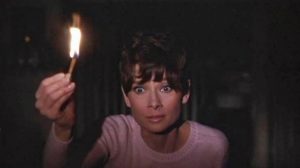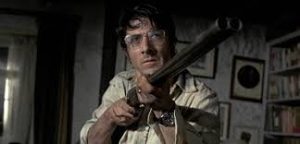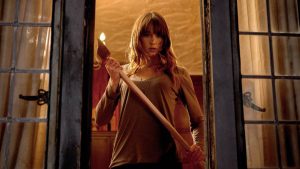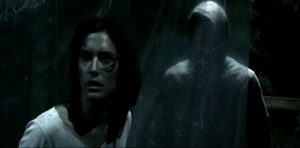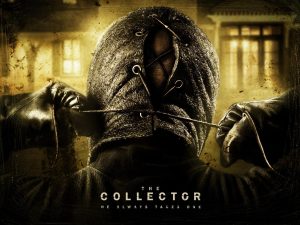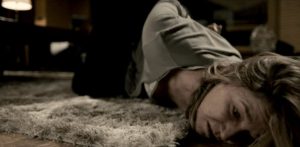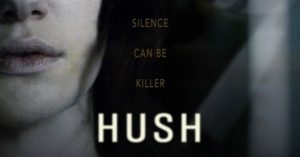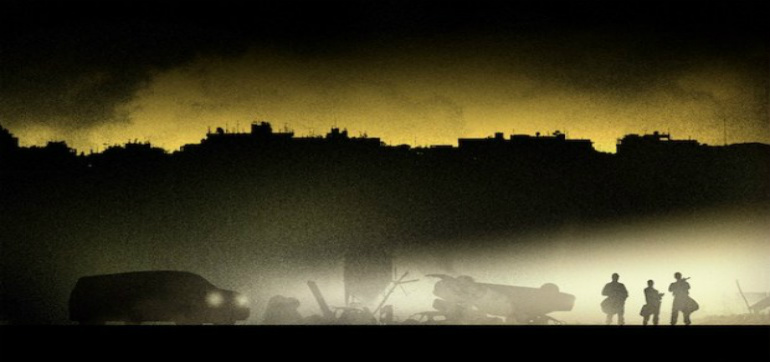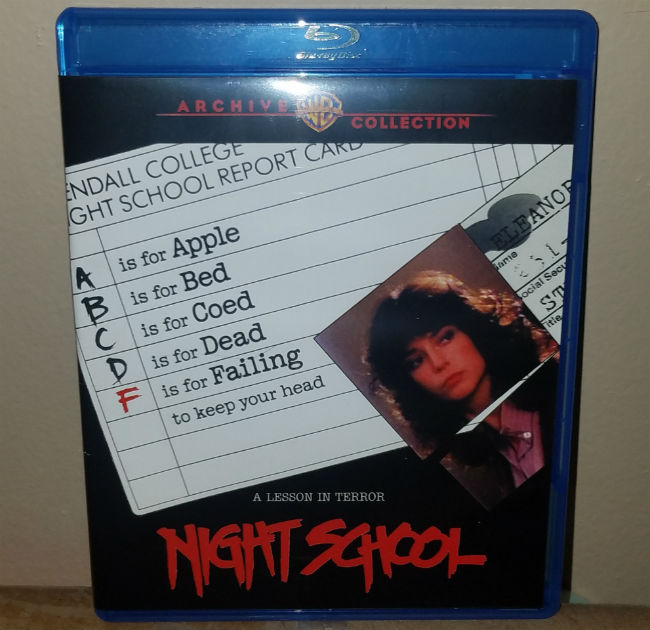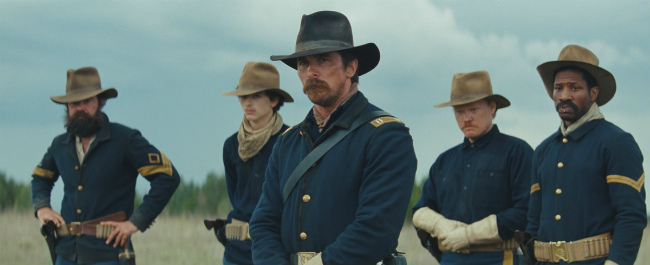Home Invasion Horror
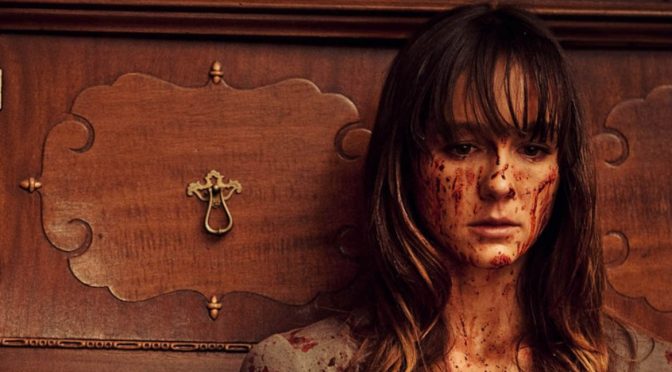
Your house. Your home. Your castle, casa, or domicile. No matter what you call it your home should a place of safety and comfort. It should be a place where you can let your guard down, be with your family, and enjoy a few hours away from the grind of everyday life. But what happens when all that is taken away and our safe, comfortable existence is shattered?
Ingmar Bergman studied the effects of the shattered home life in The Virgin Spring (1960). Max Von Sydow (Game of Thrones) plays a farmer in medieval Sweden. His daughter, Karin, leaves their farm with a servant girl to attend a religious festival. However, only the servant returns.
Karin and Ingeri, the servant, meet three traveling goat herders. If the herders ever had good intentions they disappeared shortly after meeting the girls. Ingeri escapes, but the herders rape and murder Karin.
Later, the attackers seek refuge at Tore’s farm. The hitch is the herders don’t know they’ve asked help from the dead girl’s father. Tore and his wife soon discover the men were responsible for the death of their daughter.
It’s at this point in the movie Tore is torn between giving the lost travelers aid or getting revenge for his daughter. In the end, Tore and his wife do find the justice they were seeking. However, Bergman asks the question, “At what price?”
The Virgin Spring isn’t necessarily a horror movie in the sense that we have come to know horror movies. Some horror historians may not even recognize the movie as such, but Spring is possibly the first movie in modern times to explore the notion that we’re not safe in our homes. It also inspired a director who would do more for horror movies than any other director in the 20th century.
The late sixties and early seventies saw two entries in the home invasion genre worth mentioning.
Terence Young (Thunderball, Dr. No, From Russia With Love) put a blind Audrey Hepburn (Breakfast at Tiffany’s, Roman Holiday) through a terror filled night in Wait Until Dark. Yes, that Audrey Hepburn, America’s sweetheart who starred in Roman Holiday, Breakfast at Tiffany’s, and Sabrina.
Some of the scenes, especially the scenes with Alan Arkin, seem clunky by today’s standards. At other points, the viewer is left scratching their heads- Did we really just watch a blind woman open the refrigerator door for light? However, Young managed to capture the claustrophobia and fear of being trapped in your home. It’s a theme that is visited time and time again in home invasion movies.
In 1971, Richard Fleischer directed See No Evil. See No Evil shares many similarities to Wait Until Dark. Like Audrey Hepburn’s Susy, Sarah (Mia Farrow, Rosemary’s Baby) is blind. And like Susy, Sarah is on the run from thugs intent on doing her harm.
.
See introduces a new level of violence not seen in the previous movies. The violence is tame compared to today’s home invasion movies, but it set a precedent many other movies would follow.
However, it wasn’t until Straw Dogs (1971) the many of the pieces of the home invasion genre were brought together in one movie.
By now the setting of Straw Dogs and the plot will seem very familiar. David (Dustin Hoffman) and Amy (Susan George) rent an isolated house in the English country. Shortly after, David and Amy are terrorized by the locals who don’t really appreciate “outsiders.”
Straw Dogs is a violent movie. There’s no arguing against the fact. There’s rape, murder, and violence in abundance. Even today, some viewers may find scenes to harsh to watch. Peckinpah (The Getaway, The Killer Elite) was never one to shy away from violent, intense movies. The Wild Bunch was criticized for the amount of blood and violence. In his review, Roger Ebert called The Wild Bunch “possibly the most violent film ever made.” Peckinpah didn’t hold back with Straw Dogs either.
Unlike some of its modern counterparts there’s a point to the violence. A purpose beyond the sake of showing violence. At the beginning of the movie, David is a timid character. By the end of the move, David has changed into something else. The violence brings out a side of David he never knew existed. Characters in today’s home invasion movies, with rare exception, are the same at the end as they were at the start of the movie.
However, it was Wes Craven’s The Last House on the Left that has inspired more home invasion films than perhaps any other movie.
Craven’ Last House may seem very similar to Bergman’s Virgin Spring. It should. The Virgin Spring was a direct influence on Craven when he decided to make The Last House on the Left.
The influence is apparent. In Last House, a family settles into their vacation home. Against their better judgement the parents let their daughter go into the city with a friend. After a night of partying the two girls head back home. Along the way the girls run into three criminals. The criminals murder the daughter. Or so they think. Like the herders in The Virgin Spring, the criminals find themselves at the parents’ house. From there, the violence starts and doesn’t end til the credits.
Last House on the Left was banned in the UK for years due to the sadistic acts in the movie. Although the blood and gore is tame and obviously fake it wasn’t until recently that the UK lifted the ban. Last House is tame compared to today’s home invasion movies.
REVIEWS
The years haven’t been kind to the home invasion genre. The movies, for the most part, have become stale and boring. The elements are basically the same from one movie to the next. A family or couple move into a home or already live in an isolated location.Vacation homes are also a favorite target (Apparently, you have to be rich to be a target in these movies). The family is targeted by an individual or a group. Sometimes we get a reason why the family is being terrorized, but more often than not the viewer has to accept whatever pretense the movie establishes.
The Resident,Trapped, Trespass, Pacific Heights, Lakeview Terrace,No Good Deed, The Guest, The Strangers. The Gift and the Eli Roth’s abysmally awful Knock,Knock are just a few of the home invasion movies that recycle the same-old-same-old.
(To be fair, Knock, Knock isn’t typical. However, it’s so bad that no one should be subjected to this kinds of movie. It’s difficult to say whether it’s Roth’s sex-fantasy-gone-bad plot or Keanu Reeves’s bad acting that makes it a bad movie.)
FUNNY GAMES
Michael Haneke’s Funny Games (both versions) tried to break the mold. Funny Games’s story line isn’t original or even different from other home invasion movies. A family is settling into their vacation home only to be terrorized and murdered by psychopaths. In this case, the psychopaths are two brothers.
In some aspects, Haneke achieved something more than the typical home invasion movie. In many scenes, Haneke breaks the fourth wall. One moment we’re watching the brothers torture a family, the next they’re looking straight at us.
The effect of having a character in a movie acknowledge the audience jars it from the action on the screen. The viewer is forced to ask, “What’s happening?” When we think we’re going to get an answer the violence and torture on screen continues.
In one of the weirdest scenes, Haneke “rewinds” the movie. For a brief moment it looks like Ann, the mother has killed the younger brother and will save the family. Paul, the older brother, grabs the television remote and rewinds the movie. Everything is like it was before, but now the two brothers are back in control.
While the movie’s story may not be original what Haneke is saying with the movie is original. By breaking the fourth wall Haneke is admonishing his audience. The characters are looking at us looking at them. They’re daring us to keep watching and we do. We are being judged for not turning the movie off.
Haenke is also saying we like these kinds of movies. He rewinds the movie because we want the brothers to win. We don’t want to see a version of the movie where the family survives. The brothers leave the house we know they’re moving onto another family. Maybe it’s the family next door or down the street or even in another town.
You’re Next
You’re Next is one of the few home invasion films to flip the script on the standard, dull formula. The movie’s start is fairly standard. Kids reunite to celebrate their parents’ wedding anniversary. The first act does a good job establishing the sibling rivalries and the buried animosities the kids have towards each other and their parents. It’s enough to distract us so when the violence starts in the second act it catches the viewer off guard.
What makes You’re Next worth the watch is the main character, Erin. Director Adam Wingard does a good job slowly developing the character. Bread crumbs are dropped along regarding her background she doesn’t want to talk about. The whole movie shifts to Erin becoming the hero when it’s revealed she was raised by survivalist parents and on a pseudo-military compound.
The tables are turned on the home invaders. Unlike, other home invasion movie, the tables stay turned. Unfortunately, Wingard didn’t know when to end the movie. Instead of having a satisfying ending where Erin walks away, Wingard adds one last scene that detracts from an otherwise great movie.
THEM
One of the more disturbing home invasion films to come out in recent years is the French film Them.
It’s a pretty standard home invasion movie. Clementine and Lucas retreat to their vacation home to get away from the hustle and bustle of the city. Not long after settling in for the night, on their first day, the couple are terrorized by home invaders.
The action is typical. The sequence of couple separating, promising to be okay, and running from attackers is uninspired. Even following one of the attackers who the couple think is helping has been used in other movies.
What separates Them from the rest of the pack are the perpetrators. Attackers in other home invasion horror movies are usually adults. In Them, the attackers are children and if we are to believe the epilogue the story was based on a true story.
Kids killing people because they’re bored is a disturbing enough story. Add in the fact that the events, in one form or fashion, may have actually happened is even more disturbing.
The Collector
If you take a healthy dose of Saw and add it to a home invasion movie you’ll have The Collector.
In short, Arkin (Josh Stewart, The Dark Knight Rises) is a handy man who just completed work on the Chase’s home. He’s in need of quick money to help his ex-wife so he does what anyone convicted of burglary does, he breaks into the Chase home to rob them. By the time Arkin is in the house the Collector has already set up his traps.
Arkin’s journey through the house is agonizing to watch. When he avoids one trap he springs another trap. By the end of the movie, Arkin has had his fingers broken, his face cut into by fish hooks, and been attacked by the Collector.
Arkin has been through hell and came out the other side a better person. His escape from the horror house with Hannah is a satisfying end without the viewer being cheated. The movie should have ended here.
Unfortunately, the movie doesn’t end at this point. Director Marcus Dunstan clearly planned a sequel or two. It’s a shame because an ending where Arking saves the girl and helps his wife out would have been the best ending.
In Their Skin
In Their Skin is the home invasion movie fans should all see at least once. The story is basic. Mary and Mark, with their son in tow, head to their vacation home hoping to mend their marriage which has been affected by the death of their child.
Shortly after their arrival they are befriended by Bobby, Jane, and their “son.” Jared. Or so it would seem at first. Bobby, Jane, and Jared have other plans. The plan is to kill Mary, Mark, and Bredon, the son, and assume their identities. They’ve done it in the past and for much of the movie it looks like they’ll get away with it again.
Like David and Amy in Straw Dogs, Mary and Mark begin the movie repressed, sad, and not individuals prone to protect themselves. The two argue with each other through the movie as to what course of action they should take against Bobby and Jane. When they do start to fight back their actions are believable. There’s no crazy, over-the-top action.They do things that you and I would do in the same situation.
In Their Skin is believable which makes it one of the more disturbing home invasion movies to come out in decades.
KIDNAPPED
There’s plenty of blood, violence, and even a rape scene for good measure in Kidnapped. There’s the obligatory villain who’s not as bad as the others. There’s even the required scenes to make it seem like the family has won and everything will be okay.
What separates Kidnapped from the rest is the brutality perpetrated on the family. Kidnapped is harsh. Director Miguel Angel Vivas assaults the viewer every chance he gets.
The worse assault is at the end of the third act when the viewers think the family made it out alive. The viewer’s hopes are lifted. The family has survived a night of torture. However, the ending will leave you speechless.
Never mind that Kidnapped has subtitles, if you’re a fan of the genre you must watch this movie.
HUSH
Like Wait Until Dark and See No Evil, the main character in Hush has a disability. Maddie (Kate Siegel, Oculus) is deaf. It’s an interesting twist used to great effect. Maddie can see what the Man (The only name he is given in the credits) is doing and sometimes can read lips. Hush is the ultimate cat-and-mouse game of home invasion horror movies.
Most of us will go through life never knowing what it feels like having their home invded. Maybe that’s why we like watching home invasion horror movies. We can watch in the comfort of our own homes, secure in the fact it’s only a movie. But somewhere in the back of our minds there is a fear that it could happen to us. A fear better explored in horror movies than in real life.


